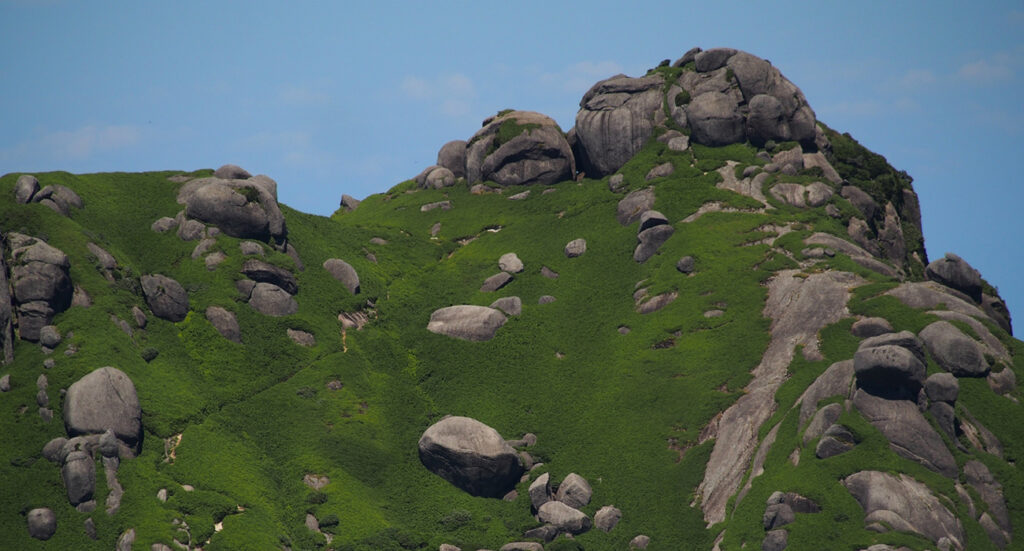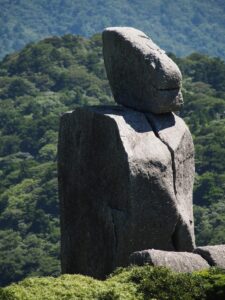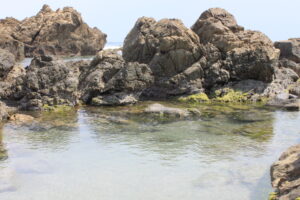THE NATURE
GEOLOGY
Understand the rock to understand the island
The alps of the ocean
Yakushima, a small island, roughly 130km in circumference has the highest mountains in Kyushu, while less than 10km away the neighbouring Tanegashima barely rises above sea level.
Both Yakushima and Tanegashima share the same base rock – the Kumage group. The Kumage group is a sedimentary group of rocks that began to accumulate 60 million years ago from sand and mud deposits built up on the ocean floor.
For millions of years the islands of Tanegashima and Yakushima were formed in similar ways until around 15.5 million years ago when molten granite 10km below Yakushima was formed and began to be forced upwards on a tectonic plate movement. The granite began to intrude into the Kumage group stratum and pushed it up just below the island. The subterranean granite rose at a steady 1 metre per thousand years (and continues to rise, but at a slower rate), eventually creating the dramatic mountain landscape that exists today. 15 million years later, Tanegashima remains a flat and low island, and is still made up of the older shale and sandstone, while the geology of Yakushima consists of mostly granite. Granite is a hard, granular, igneous rock characterised as containing at least 20% quartz. However, the Yakushima granite is soft and is (fortunately!) not a good building material due to its very rough consistency and large, white potassium feldspar crystals.

Mountain Monoliths
 If you make the hike up to the ‘Okudake’ central mountains you will be stunned by the surreal landscape of huge rocks that seem to have fallen on to the mountain tops. These monoliths are actually formed from granite that has been exposed to millions of years of erosion and weathering.
If you make the hike up to the ‘Okudake’ central mountains you will be stunned by the surreal landscape of huge rocks that seem to have fallen on to the mountain tops. These monoliths are actually formed from granite that has been exposed to millions of years of erosion and weathering.
Closer to the coast you can visit the Senpiro Waterfall to see how its force has shaped the huge granite banks on either side of the waterfall. The Senpiro Waterfall exposes the largest single granite rock in the country. So impressive were/are some of these monoliths that they were/are deemed to contain the dieties of the island and annual pilgrimages undertaken by the islanders make their way to the summit of the mountain tops and often include a visit to one or two of these special rocks.
Coastal Geology
 Yakushima is not a volcanic island, but there are a few lava fields on the island, particularly on the Tashiro Coast on the east of the island and surrounding the Hirauchi Sea Onsen in the south. The lava outcrop has been given the name ‘Pillow shaped lava field’ due to it apparently looking like bundles of pillows. The lava came from a huge eruption to the south and became an addition to the Kumage group due to tectonic plate movement.
Yakushima is not a volcanic island, but there are a few lava fields on the island, particularly on the Tashiro Coast on the east of the island and surrounding the Hirauchi Sea Onsen in the south. The lava outcrop has been given the name ‘Pillow shaped lava field’ due to it apparently looking like bundles of pillows. The lava came from a huge eruption to the south and became an addition to the Kumage group due to tectonic plate movement.


